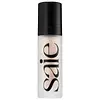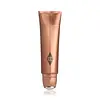Saie Glowy Super Gel Lightweight Dewy Highlighter Versus Charlotte Tilbury Supermodel Body Highlighter
What's inside
What's inside
 Key Ingredients
Key Ingredients

 Benefits
Benefits

 Concerns
Concerns

 Ingredients Side-by-side
Ingredients Side-by-side

Water
Skin ConditioningCaprylic/Capric Triglyceride
MaskingPropanediol
SolventGlycerin
HumectantMica
Cosmetic ColorantHydroxyethyl Acrylate/Sodium Acryloyldimethyl Taurate Copolymer
Emulsion StabilisingSqualane
EmollientCaprylyl Glycol
EmollientPhenethyl Alcohol
MaskingEthylhexylglycerin
Skin ConditioningPolysorbate 60
EmulsifyingAscorbyl Tetraisopalmitate
AntioxidantCarica Papaya Seed Oil
HumectantRosa Canina Fruit Oil
EmollientLactic Acid
BufferingCI 77891
Cosmetic ColorantCI 77491
Cosmetic ColorantWater, Caprylic/Capric Triglyceride, Propanediol, Glycerin, Mica, Hydroxyethyl Acrylate/Sodium Acryloyldimethyl Taurate Copolymer, Squalane, Caprylyl Glycol, Phenethyl Alcohol, Ethylhexylglycerin, Polysorbate 60, Ascorbyl Tetraisopalmitate, Carica Papaya Seed Oil, Rosa Canina Fruit Oil, Lactic Acid, CI 77891, CI 77491
Water
Skin ConditioningCaprylic/Capric Triglyceride
MaskingButylene Glycol
HumectantDimethicone
EmollientMica
Cosmetic ColorantGlycerin
HumectantGlyceryl Stearate
EmollientPEG-100 Stearate
Alcohol Denat.
AntimicrobialCetearyl Alcohol
EmollientCI 77891
Cosmetic ColorantMenthyl Lactate
MaskingPhenoxyethanol
PreservativeHydroxyethylcellulose
Emulsion StabilisingCaramel
Cosmetic ColorantEthylhexylglycerin
Skin ConditioningCarbomer
Emulsion StabilisingCI 77491
Cosmetic ColorantXanthan Gum
EmulsifyingSilica
AbrasiveHydrolyzed Viola Tricolor Extract
Skin ProtectingAllantoin
Skin ConditioningCaffeine
Skin ConditioningDisodium EDTA
Menthol
MaskingCamellia Oleifera Seed Oil
Skin ConditioningRosa Canina Fruit Oil
EmollientCI 77492
Cosmetic ColorantSodium Hydroxide
BufferingCI 77499
Cosmetic ColorantRosa Damascena Extract
MaskingPEG-8
HumectantAloe Barbadensis Leaf Juice Powder
Skin ConditioningMichelia Alba Leaf Oil
MaskingSodium Hyaluronate
HumectantTocopherol
AntioxidantPentylene Glycol
Skin ConditioningLentinus Edodes Extract
Skin ConditioningTin Oxide
AbrasiveAscorbyl Palmitate
AntioxidantAscorbic Acid
AntioxidantCitric Acid
BufferingLinalool
PerfumingCitronellol
PerfumingGeraniol
PerfumingWater, Caprylic/Capric Triglyceride, Butylene Glycol, Dimethicone, Mica, Glycerin, Glyceryl Stearate, PEG-100 Stearate, Alcohol Denat., Cetearyl Alcohol, CI 77891, Menthyl Lactate, Phenoxyethanol, Hydroxyethylcellulose, Caramel, Ethylhexylglycerin, Carbomer, CI 77491, Xanthan Gum, Silica, Hydrolyzed Viola Tricolor Extract, Allantoin, Caffeine, Disodium EDTA, Menthol, Camellia Oleifera Seed Oil, Rosa Canina Fruit Oil, CI 77492, Sodium Hydroxide, CI 77499, Rosa Damascena Extract, PEG-8, Aloe Barbadensis Leaf Juice Powder, Michelia Alba Leaf Oil, Sodium Hyaluronate, Tocopherol, Pentylene Glycol, Lentinus Edodes Extract, Tin Oxide, Ascorbyl Palmitate, Ascorbic Acid, Citric Acid, Linalool, Citronellol, Geraniol
 Reviews
Reviews

Ingredients Explained
These ingredients are found in both products.
Ingredients higher up in an ingredient list are typically present in a larger amount.
This ingredient is an emollient, solvent, and texture enhancer. It is considered a skin-softener by helping the skin prevent moisture loss.
It helps thicken a product's formula and makes it easier to spread by dissolving clumping compounds.
Caprylic Triglyceride is made by combining glycerin with coconut oil, forming a clear liquid.
While there is an assumption Caprylic Triglyceride can clog pores due to it being derived from coconut oil, there is no research supporting this.
Learn more about Caprylic/Capric TriglycerideCi 77491 is also hydrated iron III oxide. It's sole purpose is to give a red/pink hue to products.
Iron III oxides are classified as inorganic chemicals for coloring.
Synthetically created Ci 77491 is considered safer than those naturally found. This is because the synthetically created version may contain less impurities. Iron oxides are generally non-toxic and non-allergenic.
Learn more about CI 77491Ci 77891 is a white pigment from Titanium dioxide. It is naturally found in minerals such as rutile and ilmenite.
It's main function is to add a white color to cosmetics. It can also be mixed with other colors to create different shades.
Ci 77891 is commonly found in sunscreens due to its ability to block UV rays.
Learn more about CI 77891Ethylhexylglycerin (we can't pronounce this either) is commonly used as a preservative and skin softener. It is derived from glyceryl.
You might see Ethylhexylglycerin often paired with other preservatives such as phenoxyethanol. Ethylhexylglycerin has been found to increase the effectiveness of these other preservatives.
Glycerin is already naturally found in your skin. It helps moisturize and protect your skin.
A study from 2016 found glycerin to be more effective as a humectant than AHAs and hyaluronic acid.
As a humectant, it helps the skin stay hydrated by pulling moisture to your skin. The low molecular weight of glycerin allows it to pull moisture into the deeper layers of your skin.
Hydrated skin improves your skin barrier; Your skin barrier helps protect against irritants and bacteria.
Glycerin has also been found to have antimicrobial and antiviral properties. Due to these properties, glycerin is often used in wound and burn treatments.
In cosmetics, glycerin is usually derived from plants such as soybean or palm. However, it can also be sourced from animals, such as tallow or animal fat.
This ingredient is organic, colorless, odorless, and non-toxic.
Glycerin is the name for this ingredient in American English. British English uses Glycerol/Glycerine.
Learn more about GlycerinMica is a naturally occurring mineral used to add shimmer and color in cosmetics. It can also help improve the texture of a product or give it an opaque, white/silver color.
Serecite is the name for very fine but ragged grains of mica.
This ingredient is often coated with metal oxides like titanium dioxide. Trace amounts of heavy metals may be found in mica, but these metals are not harmful in our personal products.
Mica has been used since prehistoric times throughout the world. Ancient Egyptian, Indian, Greek, Roman, Aztec, and Chinese civilizations have used mica.
Learn more about MicaRosehip Oil is a non-fragrant plant oil. Rosehips are a fruit from a rose bush and are edible. This oil has skin conditioning and hydrating properties.
Rosehip contains Vitamin C, Vitamin E, fatty acids and linolenic acids. These nourish your skin barrier. Having hydrated skin may help reduce the appearance of fine-lines and wrinkles.
Another great component of Rosehip Oil is Vitamin A, or retinol. Vitamin A encourages your skin to create more collagen.
Rosehip oil may help with reducing pigmentation. The lycopene and beta-carotene have skin-lightening properties. However, more studies are needed to confirm this.
Learn more about Rosa Canina Fruit OilWater. It's the most common cosmetic ingredient of all. You'll usually see it at the top of ingredient lists, meaning that it makes up the largest part of the product.
So why is it so popular? Water most often acts as a solvent - this means that it helps dissolve other ingredients into the formulation.
You'll also recognize water as that liquid we all need to stay alive. If you see this, drink a glass of water. Stay hydrated!
Learn more about Water